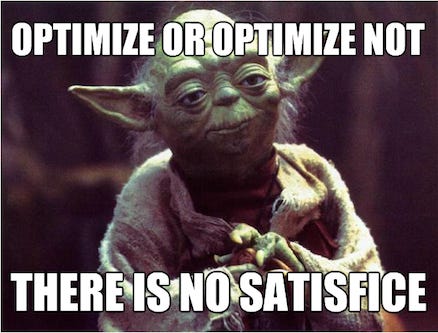When to Optimize
The Hidden Cost of Process Improvement
Hello everyone,
Last week, I found myself in a situation that might sound familiar to many of you. Our marketing team was preparing for a quarterly campaign launch, and I noticed Person spending hours creating an elaborate spreadsheet system to track our social media posts.
"This will save us so much time!" they exclaimed, showing me color-coded cells, dropdown menus, and intricate formulas.
Three days later, the campaign was live, but Person had spent nearly 20 hours building their tracking system for a campaign that would only run for six weeks with twelve scheduled posts.
This got me thinking about a common trap many of us fall into: over-optimization of our working processes. While improving efficiency is valuable, we need to be strategic about when and what to optimize.
The Optimization Paradox
We often spend more time optimizing a process than we'll ever save from the optimization itself.
This creates a net negative return on our investment of time and energy.
In Person's case, even if her system saved 30 minutes per post (an optimistic estimate), the total time saved would be 6 hours, far less than the 20 hours invested in creating the system. And once the campaign ended, most of her work would never be used again.
I've seen this happen repeatedly in teams where elaborate systems are built to save minutes, while consuming days of setup time. That project management tool that took two weeks to customize? The team abandoned it after three months. The automated report that required 40 hours of coding? It's now obsolete because the metrics we track have changed.
The ROI of Optimization
When deciding whether to optimize a process, consider this simple formula:
Time saved per use × Number of future uses > Time spent optimizing
This means optimization makes sense when:
1. The process is frequently repeated - The more often you'll use the improved process, the greater the cumulative benefit
2. The potential time savings per use is significant - Small improvements to frequently used processes can add up
3. The optimization effort is relatively small - Quick wins should be prioritized
Take my own experience with email templates. I spent 45 minutes creating templates for common client responses. Since I send about 15 similar emails per week, saving 3 minutes per email, I recoup my investment in just 1 week. That's a clear win.
When NOT to Optimize
Avoid optimization when:
- You'll only use the process a few more times - If you'll only do something 2-3 more times, manual execution is often more efficient
- The process is likely to change soon - Don't invest in optimizing something that may become obsolete
- The optimization requires significant learning or setup time - The learning curve may exceed the benefits, but sometimes is still fun and worth exploring 🧐
- The current process works adequately - Sometimes "good enough" truly is good enough
I remember when our development team spent two weeks automating our deployment process, only to switch to a different platform three months later. All that optimization work became instantly worthless.
The 5/50/500 Rule
Consider this guideline I've developed after years of watching optimization efforts succeed and fail:
- For processes you'll use fewer than 5 times: Don't optimize
- For processes you'll use 50+ times: Consider light optimization
- For processes you'll use 500+ times: Invest in thorough optimization
This rule has saved me countless hours of unnecessary optimization work. When a new team member suggested we create an automated system for our quarterly budget reviews, I realized we'd only use it 4 times per year. Following the 5/50/500 rule, we stuck with our manual process and saved ourselves days of unnecessary work.
The Human Factor
There's another dimension to consider: optimization often removes valuable human judgment and flexibility.
Last year, our customer service team implemented a highly optimized ticketing system. While it was technically more efficient, it removed the personal touch our representatives previously brought to customer interactions. Complaints increased, and we eventually reverted to a simpler system that allowed more human discretion.
Sometimes, the "inefficiencies" in our processes are actually features, not bugs. They create space for creativity, adaptation, and the human touch that makes our work meaningful.
Final Thought
The most valuable optimization is knowing when not to optimize at all. By being selective about our improvement efforts, we can focus our energy where it truly matters and avoid the optimization trap.
The next time you find yourself about to invest significant time in optimizing a process, pause and run the numbers. Is this truly worth the effort, or are you optimizing for optimization's sake?
As for Person and her elaborate tracking system? We've now implemented a "quick calculation" step before any optimization project. It's saved us from countless hours of unnecessary work now that's an optimization worth making!
Until next time,
Luca
Nerd Out Links
If you're interested in diving deeper into the topic of strategic optimization, check out these fascinating resources:
- The Efficiency Paradox: What Big Data Can't Do - Edward Tenner explores how our obsession with efficiency can sometimes lead to unexpected inefficiencies.
- Slack: Getting Past Burnout, Busywork, and the Myth of Total Efficiency - Tom DeMarco argues that building some "slack" into our systems actually makes them more effective.
- The Myth of Multitasking: How "Doing It All" Gets Nothing Done - Dave Crenshaw explains why some "inefficient" single-tasking approaches actually lead to better outcomes.
- Why Too Much Efficiency Is Dangerous - A Harvard Business Review article on the hidden costs of maximizing efficiency.
- The Paradox of Automation: When Less Is More - Farnam Street's exploration of when automation helps and when it hinders.


